Thok’s TK01 R is the Italian brand’s hardest-hitting electric mountain bike designed for e-enduro.
Its 6061 aluminium frame boasts 170mm of rear-wheel travel and is fitted with Shimano’s EP8 motor that's connected to the 630Wh battery. To boot, it comes with a standard four-year warranty.
Unlike most cycling companies, Thok produces only ebikes. Founded in 2017 by BMX world champion and ex-World Cup downhill racer Stefano Migliorini, and joined by Livio Suppo, a former moto GP team manager for Honda and Ducati, the brand is made up of people with an impressive racing pedigree.
So can the Italian e-enduro bike cut it on the trails and in a jam-packed segment of top performers?
Thok TK01 R frame and suspension details
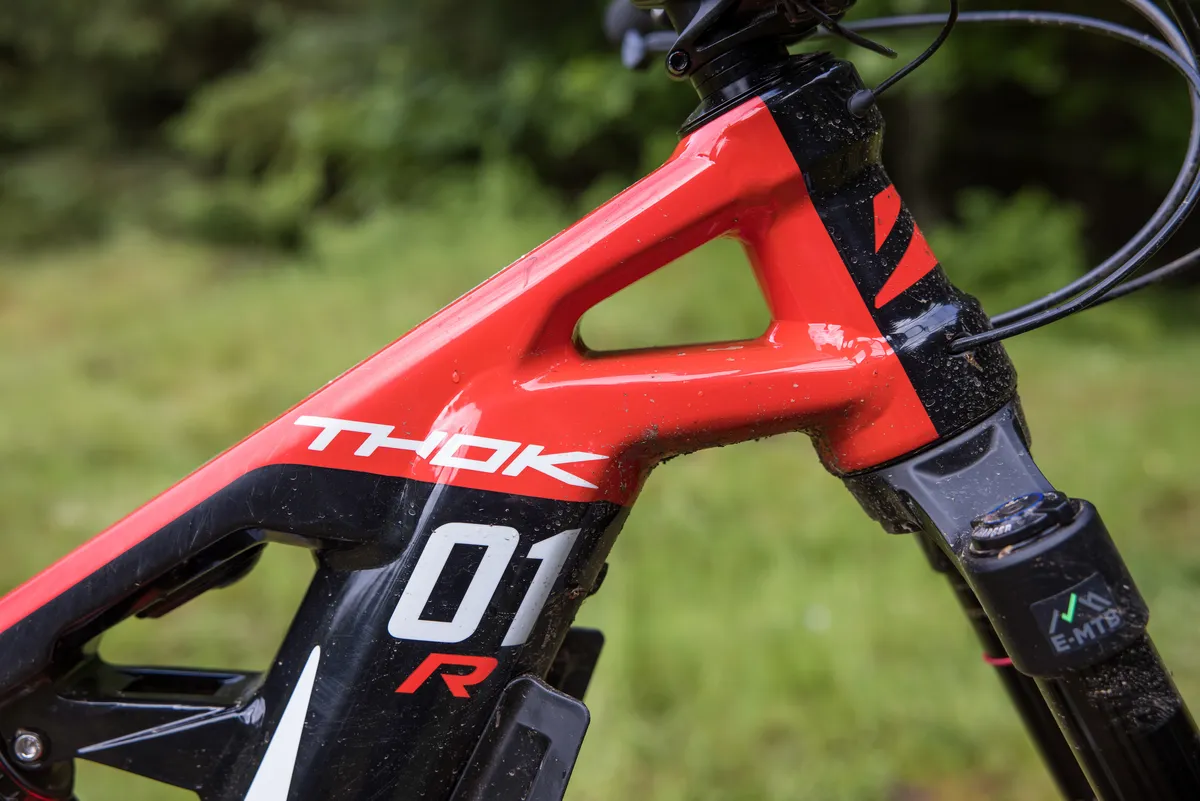
The TK01 R’s angular frame design and large, removable down tube fender-cum-mudguards – dubbed T-Wings – are clearly inspired by motocross bikes.
The bold logos, blocky graphics – styled by Drudi Performance, which pens Moto GP legend Valentino Rossi's helmets – and chunky down tube build on the look, visually underlining Thok’s claims that the TK01 R is designed to handle the toughest terrain.

Running on mullet wheels, where the front wheel diameter is 29in and the rear 27.5in, Thok isn’t alone in adopting this configuration. It says this setup helps the bike “overcome challenging obstacles and provide optimal traction…”.
Its 1.8in head tube – the latest ebike industry-standard size – has been shaped using hydroforming techniques and is claimed to improve stiffness and steering accuracy.
The top tube/head tube junction continues the flamboyant naming conventions and is called the ‘Viper Head’.

At the rear of the bike sits an in-built chainstay chainslap protector, a small seatstay bridge rear fender, and a post-mount rear brake for 200mm rear disc rotors.
Beneath the EP8 motor, there’s an impact-resistant cover to protect it from damage and inside the front triangle is a single water bottle mount. Gear, brake and dropper cables are routed internally from front to back.
Sussing out the suspension
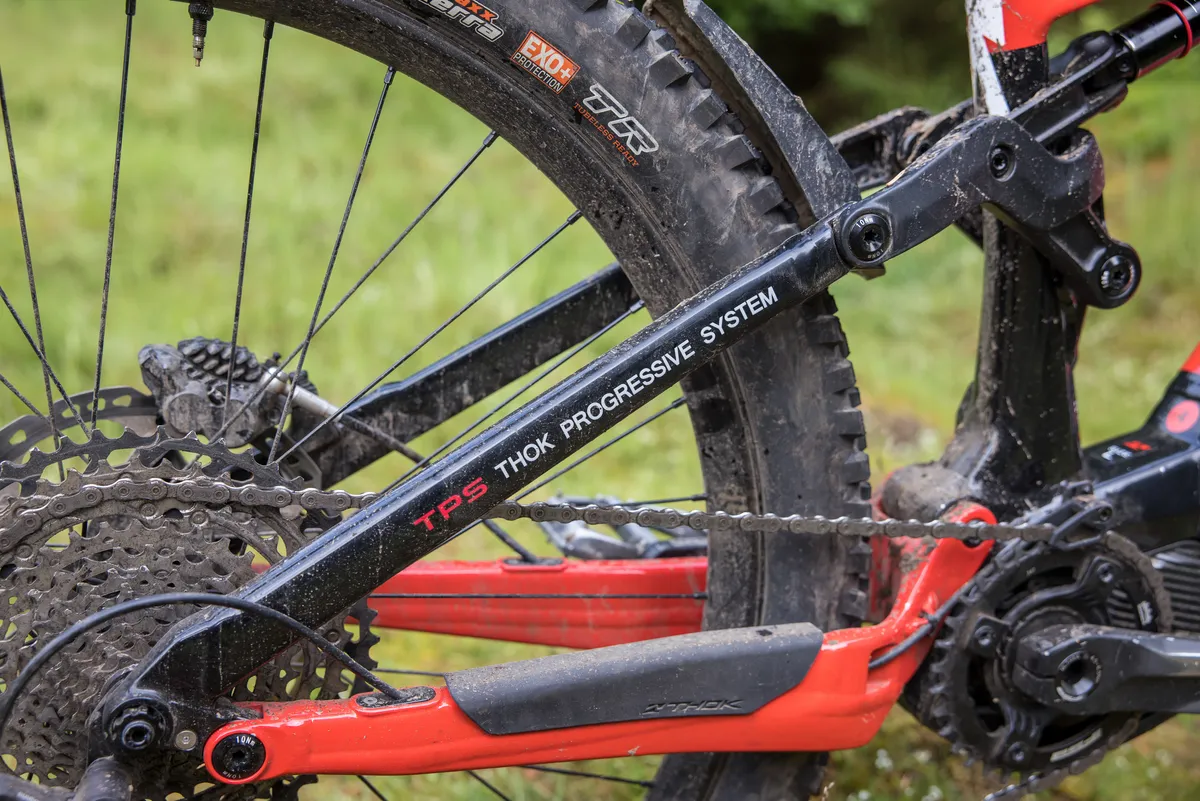
The Horst-link suspension system has 170mm of travel, controlled by a metric 230×65mm rear shock.
Thok calls its suspension the ‘Thok Progressive System’ (TPS) and claims it has been tuned to be progressive while offering the “perfect traction on all types of terrain.”
Thok TK01 R geometry
Built with a 64.5-degree head tube angle and a seat tube angle of 75.5 degrees, Thok claims the TK01 R is both comfortable and easy to control on technical terrain.
The frame’s designed to have a low standover height and short seat tube, which it says further improves control by letting a rider drop the saddle totally out of the way.
The TK01 R is offered in four sizes from small to extra-large.
The size large I tested has a 464mm reach figure, 629mm top tube and a 450mm long seat tube. Elsewhere, there’s a 453mm chainstay and 1,265mm wheelbase.
It has a claimed bottom bracket height of 355mm, although my test sample’s height measured 366mm.
| Size | Small | Medium | Large | Extra-large |
|---|---|---|---|---|
| Top tube length (mm) | 582 | 600 | 629 | 660 |
| Reach (mm) | 423 | 439 | 464 | 491 |
| Stack (mm) | 623 | 623 | 638 | 654 |
| Seat tube length (mm) | 385 | 415 | 450 | 495 |
| Chainstay length (mm) | 453 | 453 | 453 | 453 |
| Head tube angle (degrees) | 64.5 | 64.5 | 64.5 | 64.5 |
| Seat tube angle (degrees) | 75.5 | 75.5 | 75.5 | 75.5 |
| Wheelbase (mm) | 1212 | 1233 | 1265 | 1298 |
| Bottom bracket height (mm) | 355 | 355 | 355 | 355 |
Arguably, the geometry sits between the latest crop of super long, low and slack reach-focused bikes and more old-school bikes that were shorter, more upright and higher.
There’s nothing unusual about the geometry on paper, but that doesn’t necessarily mean it is a fool-proof formula for on-trail performance.
Thok TK01 R motor and battery details

The TK01 R uses Shimano’s latest EP8 motor that boasts 85Nm of peak torque and 250W of peak power. The motor’s powered by the brand’s biggest 630Wh battery which is concealed inside the down tube.
On the handlebar are Shimano’s SC-E7000 monochrome display and SW-E7000 mode selector. The on/off switch is located on the underside of the top tube just back from the head tube.
The EP8 can be connected to Shimano’s E-TUBE Project smartphone app via Bluetooth, where riders can customise each of the three mode’s (Eco, Trail, Boost) power outputs and responsiveness.
Thok TK01 R specifications

The TK01 R is Thok’s range-topper and features a host of high-performing parts.
Up front there’s a 170mm travel RockShox ZEB Select fork, which features the Charger RC damper with external low-speed compression and rebound adjustment.
At the rear is RockShox’ Super Deluxe Select+ shock, with rebound adjustment and a lockout function that’s been custom-tuned for Thok.
Shimano’s M8100 XT derailleur is matched with a M7100 SLX shifter and cassette and there are Shimano four-piston M8000 XT brakes – which use I-Spec II shifter mounts rather than the I-SPEC EV seen on the latest M8100 stoppers– with 203mm rotors.

Elsewhere, it’s fitted with Mavic E-XM 430 rims, wrapped in Maxxis’s Assegai 3C EXO+ TR 2.6in wide (both front and rear) rubber.
The TK01 R’s finishing kit is own-branded in a bid to reduce costs. There’s a 37mm long Thok stem, 780mm wide Thok bar and a Thok saddle.
The dropper post – also Thok-branded – has 170mm of travel (and its markings look identical to those found on the £600 Carrera Fury I previously tested) on the size large I tested.
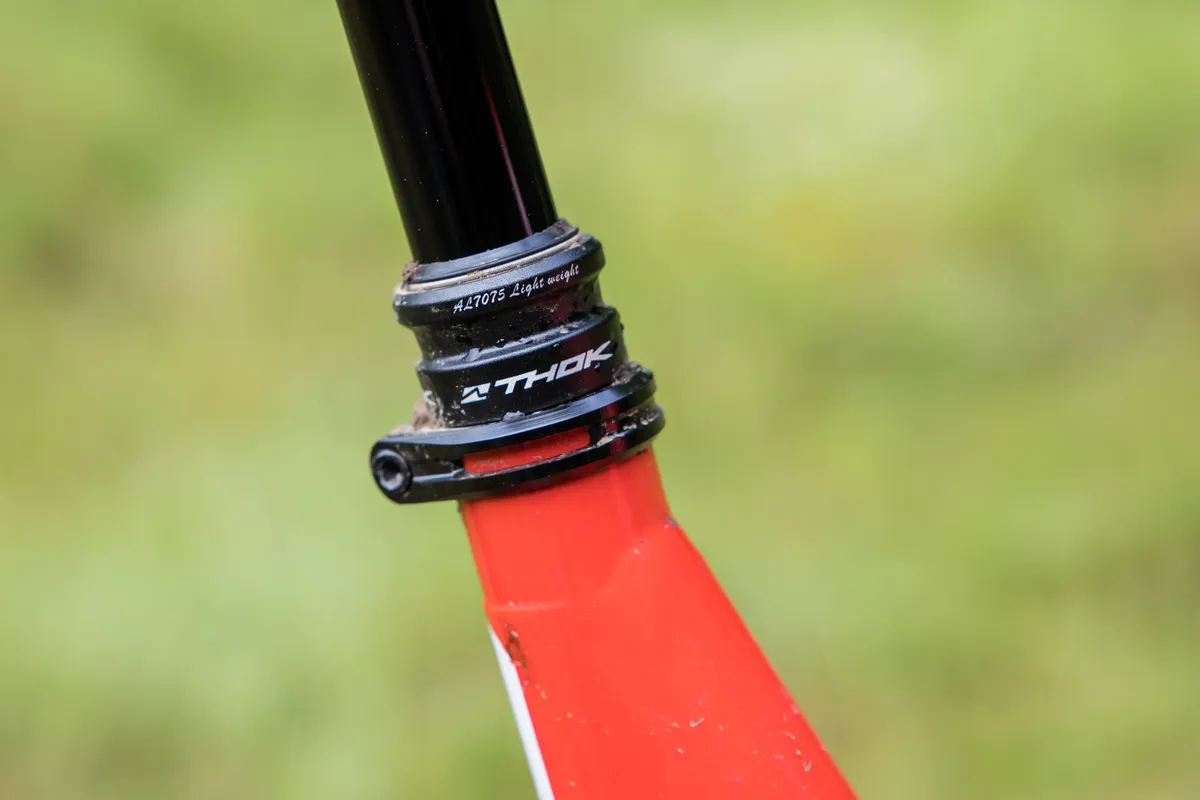
Thok’s clearly tried to be canny with where it's spent money – and saved it – hopefully creating a blend of performance and quality.
My size large TK01 R without pedals weighed 23.73kg on my scales.
Thok TK01 R ride impressions
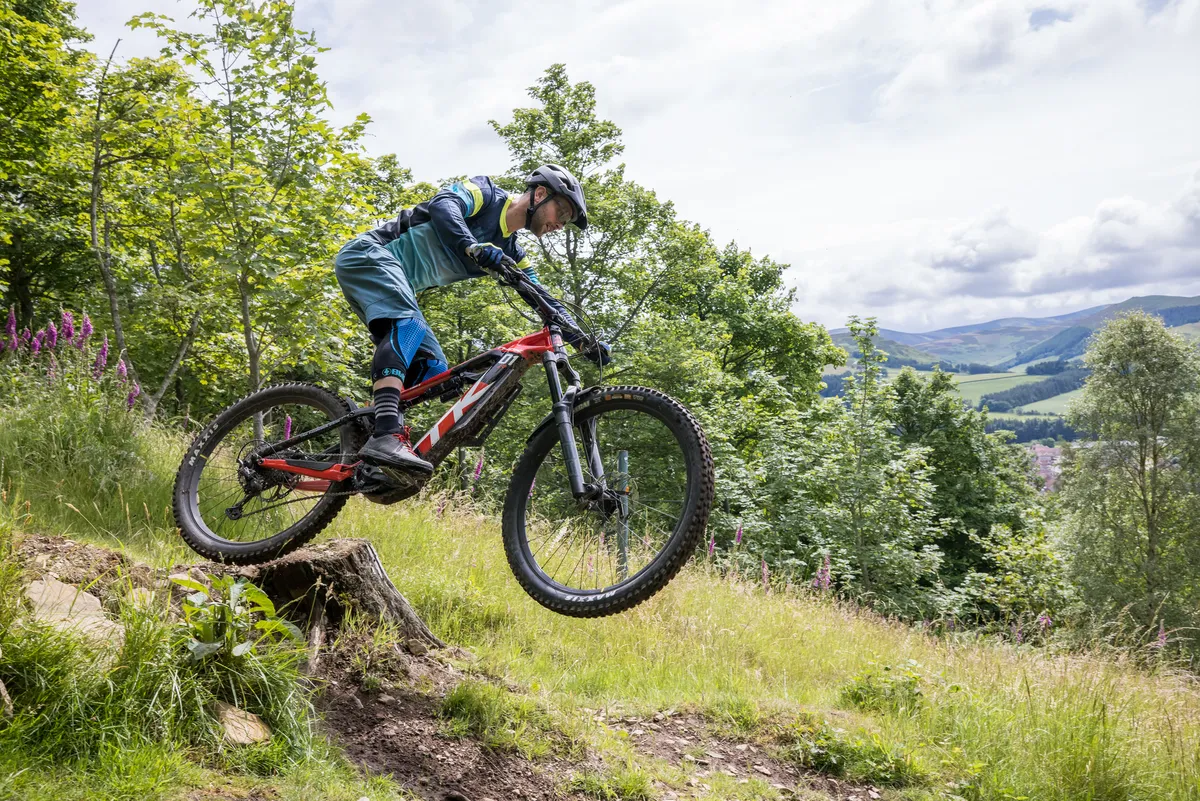
Given Thok claims its TK01 R is a thoroughbred e-enduro bike, I took that as a carte blanche to ride it on the Tweed Valley’s Enduro World Series trails, which are also my home tracks, in a bid to put it through its paces.
The terrain varied from incredibly steep on-the-brakes switchbacks to flat-out berms and high-speed, rough, rocky and rooty straight lines. I rode it at Glentress’s famous trail centre loops for good measure, too.
The type of terrain I tested the bike on represents what I expect a modern enduro rig to be able to handle day-in, day-out.
Thok TK01 R setup
Setting up the TK01 R’s suspension was simple but required some adjustment after the first ride.
For my 76kg fully kitted up weight, I ended up with three tokens in the RockShox ZEB fork and inflated the air spring to 85psi, with the compression and rebound adjustments set to fully open. This gave me around 15 per cent sag.

I left the stock number of tokens in the rear shock and ended up with 165psi in the air spring after initially trying it with more pressure. This meant the bike had 35 per cent sag, which is slightly more than my usual preferences, but in my opinion, helped improve its geometry.
I removed all the externally adjustable rebound damping and left the lockout switch in its open mode for the duration of the test.
I inflated the front tyre to 27psi and the rear to 29psi in a bid to mitigate carcass deformation and roll, and improve puncture resistance on the EXO+ casing tyres.
Using Shimano’s smartphone app, I tuned the EP8 motor to deliver 30 per cent assistance in Eco, 50 per cent in Trail and 100 per cent in Boost mode.
Thok TK01 R climbing performance

The TK01 R’s geometry and motor make it one of the best climbing electric mountain bikes out there.
The bike’s seat tube angle, chainstay and top tube figures along with the wheelbase measurement combine to create an upright and relaxed seated climbing position, where my weight felt well centralised between the front and back wheels, with a slight forward bias.
This made it easy to keep the front wheel on the ground, especially when inclines got very steep, because I was naturally placed further over the front of the bike when seated, compared to plenty of its competition.
Along with reducing front wheel lift and lightness, the bike's geometry also helped improve rear wheel traction. Because I wasn’t needing to lower my torso close to the handlebar and bring my weight forward, which in turn causes the rear wheel to spin as traction reduces, it made tackling steep ascents a controlled and enjoyable affair.
Despite the on-paper 75.5-degree seat tube angle looking pretty average – at least compared to Privateer’s 161 enduro bike’s 80-degree seat tube angle (and the E161 ebike that shares its geometry) – it doesn’t feel too slack on the trails.

Yes, I had to do my usual trick of angling the seat nose down in the post and moving it forward on its rails, but not as much as I was expecting I would. This enhanced the position the forward-biased geometry created, further improving control and composure on inclines.
Match the Thok’s geometry with the chunky treaded Maxxis Assegai 27.5×2.6in rear tyre and it feels like there’s no incline, regardless of terrain type.
Deepening its climbing ability was Shimano’s EP8 motor. Thanks to its predictable power delivery with plenty of controllable low-down torque, the Thok loved to chug to the top of the climbs at relatively low cadences and was just as happy spinning to the top at higher ones.
Controlling wheelspin was fairly easy and doing so added a rewarding but challenging element to the way it climbed. The EP8 motor does have a cadence sweet spot, though, and once I was spinning my legs at this speed, ascending was a truly enjoyable affair.
The TK01 R has other feathers to its climbing bow. Thanks to the relatively high 366mm bottom bracket and short 165mm crank arms, I found it possible to carry on pedalling around turns and along rock-strewn sections of singletrack without fear of crash-causing pedal strikes.
Removing the need for caution in chunky terrain helped increase climbing speed and, in turn, flow.
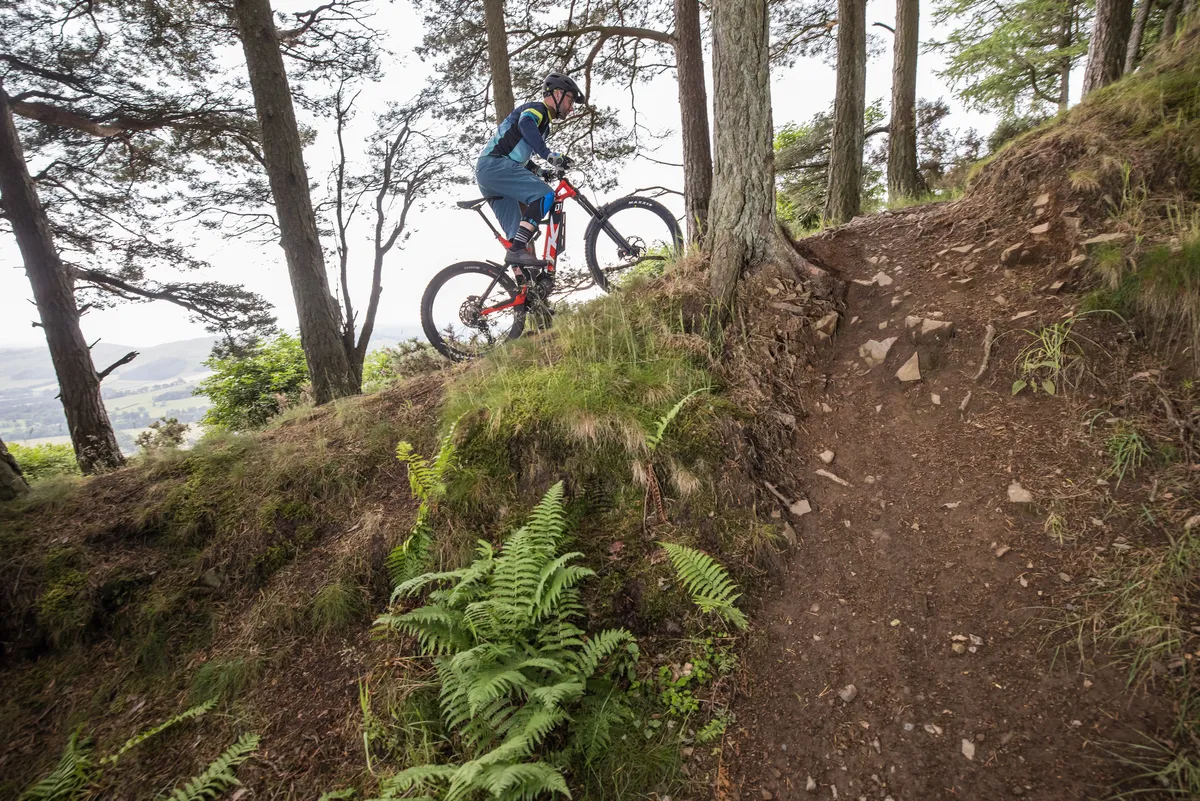
The suspension also felt supple and well-controlled, absorbing the smaller, chattery bumps while remaining supportive through larger holes and dips in the terrain, resisting bottom outs and not wallowing. This helped maintain stability, furthering control.
Although I reduced the shock’s spring pressure during the test period (as I previously mentioned) to make its geometry better suited to the descents, this didn’t appear to negatively hinder its performance on the ascents and added to the comfort provided by its rear end.
Rounding off the package was the impressively comfortable own-brand Thok Fit saddle. I found its shape and padding perfectly suited me, rivalling the performance offered by Specialized’s Bridge seat I’ve spoken about in the Specialized Fuse 27.5 review.
Thok TK01 R’s Shimano EP8 motor performance

I’ve written about how impressed I was with Shimano’s EP8 motor in my review of the Santa Cruz Bullit CC X01 RSV electric mountain bike.
The EP8’s performance doesn’t alter between bikes (unless it’s specced on a lighter, smaller battery capacity, lower-powered ebike, such as on the Orbea Rise), so everything I said in the other review about the motor stands true.
Its power is easy to control on the climbs, especially in Eco mode where traction is abundant. In Turbo, it has plenty of oomph for flat-out fireroad climbs, but this comes at the expense of battery life. Trail mode seems to strike a good balance, but each of the stock modes is customisable in the smartphone companion app, so setting the EP8 to your preferences is a doddle.
Where’s the battery percentage display?
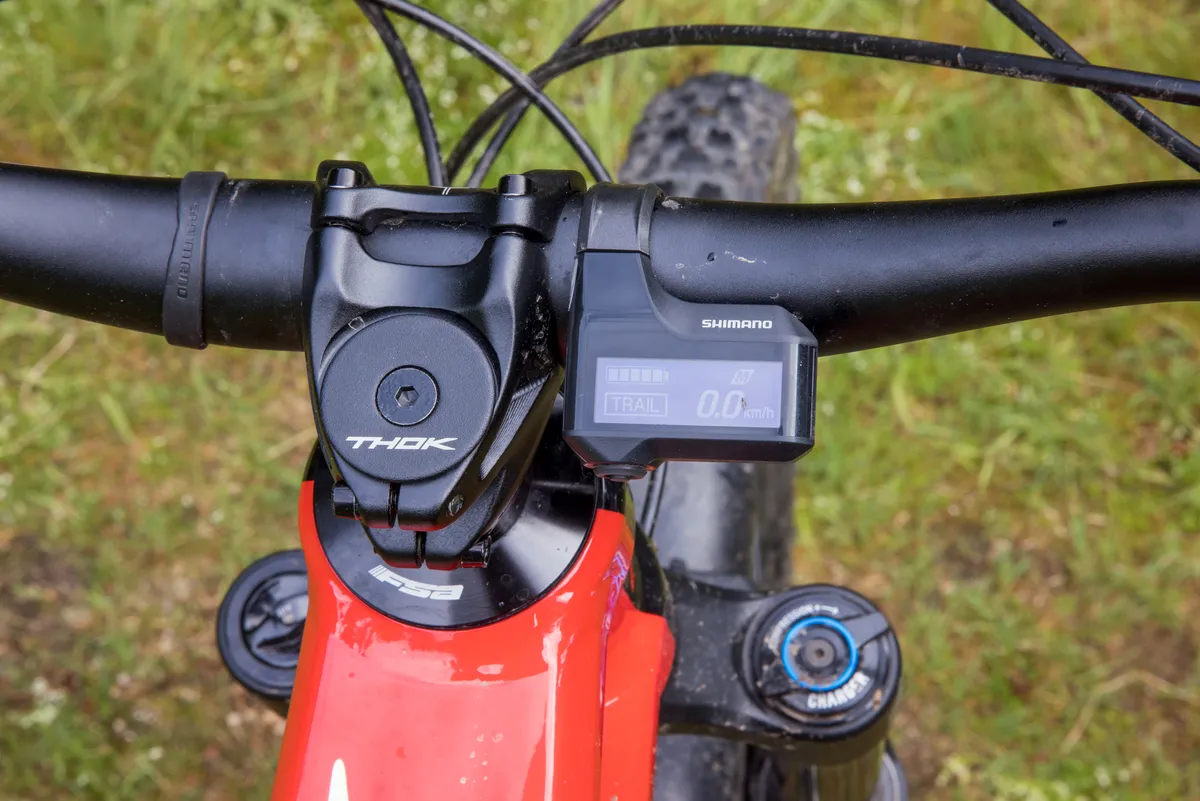
Notably, however, the five-bar battery display is frustrating, especially after spending a considerable amount of time on Specialized’s 2022 Turbo Levo that has a percentage-based battery charge indicator.
Judging how much juice you have left – and, in turn, how much further you can ride – by relying on the 20 per cent indicator blocks is frustrating at best and a gamble at worst. Plus, as the battery depletes, the blocks don’t drain evenly – the last two get used up quicker than the first two.
The display’s range indicator uses real-time calculations for its data. Cruise along the flat in Eco and the battery’s potential range will be much higher than if you’re zooming up a steep incline in Turbo. This can lull you into a false sense of security because as soon as the motor’s working harder, the range drops off rapidly.

Understandably, the bike can’t preempt how or where you’re going to ride, but an accurate percentage remaining display would help with better judging how much power remains.
Rattling distractions

The EP8’s most notable trait is something that’s informally been called the ‘death rattle’ and has been widely reported in the media. Although the death part of the description is inaccurate – the motor isn’t dying when it makes that noise – that rattle bit perfectly captures the sound the EP8 makes when you’re freewheeling.
It happens while freewheeling over rough terrain and sounds like a freehub repeatedly engaging and disengaging. Although the looseness can be felt through the pedals, beyond the noise it makes, it isn’t distracting and doesn’t appear to affect performance.
Those criticisms aside, the EP8 is a great motor that has plenty of power and torque, especially when you’re pedalling in that cadence sweet spot. Its customisability in the app is also helpful and means output and modes can be calibrated to anyone’s preferences.
How does the Shimano EP8 compare to Bosch and Specialized/Brose motors?
Compared to Bosch’s Performance Line CX motor, it isn’t quite as punchy, especially when you’re putting in very hard efforts.
The EP8’s assistance seems to taper off the harder you pedal, whereas the Bosch, especially in EMTB mode, keeps giving more assistance with a rewarding increase in speed up to the speed limiter.

Ridden back-to-back with Specialized’s Brose, the Shimano feels like it has more power and torque in any given setting, even with the Specialized’s assistance modes matched to the EP8’s output in the Mission Control app.
This is most visible on fireroad drags where the Shimano-equipped bike pulls away, even though the rider isn’t working as hard.
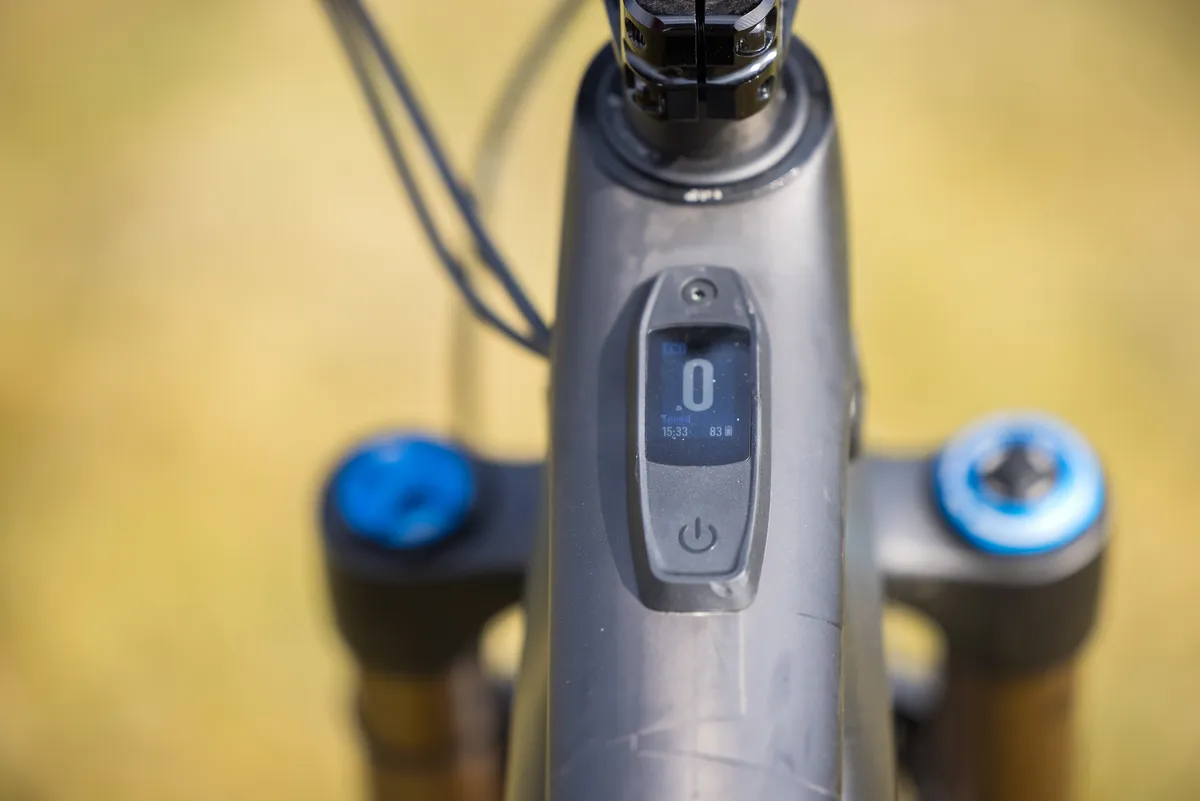
It is significantly noisier than Brose’s belt-driven setup, whether that’s while pedalling or freewheeling, and thanks to the lack of 'death rattle', the Brose feels like a much more refined package.
Thok TK01 R descending performance

Point the Thok downhill and there are situations where it truly shines, but plenty where it doesn’t.
Geometry compromises
In making the Thok climb so well, compromises have been made that impact descending prowess.
Around turns, whether flat or bermed, the front end has a tendency to push and understeer instead of gripping. A few factors seem to be combining to make this happen.
The bottom bracket’s height, head tube angle, front centre and reach, along with the overall weight of the bike made it feel like I was being pushed from behind around turns, rather than being able to easily and confidently lean it over.
This meant I was steering more than I would usually. Instead of leaning into turns, I found myself turning the bar. Leaning over felt unintuitive, a feeling compounded by how quickly the front tyre understeered and wanted to wash out.
The steeper head tube angle made it feel like my weight was further forward than it actually was. This was made more noticeable by the need to compensate for the steeper-than-I-would-prefer angle by leaning further back on the bike.
If I wasn’t careful, this made the front end too easy to load up with weight, causing the front wheel to feel like it was tucking, which exacerbated the understeer and feelings I mentioned above.
To help mitigate this problem, I reduced the rear shock’s pressure to increase sag to 35 per cent. This slackened the head tube angle and increased the wheelbase, helping improve stability and my ability to confidently get further over the front.

I also increased the number of tokens in the fork to the maximum of three from two, which provided additional bottom-out resistance, once again helping me weight the front end without fear of plunging through the fork’s travel.
Once set like this, the bike’s handling was improved. It meant I was able to commit to turns more, giving me the ability to ride the bike faster. However, the level of commitment and trust needed was certainly much higher than I was used to.
The Thok’s great in a straight line, especially on high-speed trail centre-style runs where it feels calm and fairly composed. This was created by its weight that reduced the chance of the chassis, and therefore the rider, getting upset by the terrain.
The 450mm seat tube length and post’s stack height combine to create a high-feeling rear end. For my 178cm height, I wasn’t able to drop the seat low enough so that it didn’t contact my backside when the trails got particularly steep without manually adjusting it with an Allen key.
Fitting a OneUp V2 Dropper Post would go some way to limiting that feeling because it has a very short stack height. In its compressed position, it will be lower than other posts yet still rise to the same height if a longer travel version were fitted. That said, it would be great to see shorter seat tube lengths on bikes of this ilk.
How would I improve the TK01 R’s geometry?

I’d lower the bottom bracket height, increase the reach figure and slacken the head tube angle, whilst increasing the front centre length.
I’d also shorten the seat tube length but ensure the motor or seat tube suspension linkage pivot didn’t interfere with seatpost insertion depth.
None of these numbers would have to change much, but shaving a few millimetres here, adding a few there and changing an angle or two should make a massive improvement to the way it rides.
Supple suspension
Despite increasing rear end sag, the suspension remained impressively supportive in the mid-stroke, not diving around turns or through compressions, and had plenty of bottom-out resistance.
The decrease in pressure improved small bump performance, too. However, the RockShox Super Deluxe Select+’s damper custom tune did feel a little overwhelmed at times and I couldn’t open up the rebound damping enough for my liking.
Over particularly chattery terrain, the rear end felt like it was packing down in its travel because the shock was unable to recover in time for the next bump.
Unlike other ebikes, this meant grip wasn’t as abundant as I'd hoped. Usually, the sprung to unsprung mass ratio on ebikes creates enormous amounts of traction where it’s possible to ride tricky, bumpy lines with total confidence.
Because the damper wasn’t able to move as freely as it could, the Thok struggled to generate the level of grip I experienced on the Bullit and Turbo Levo.
However, the Zeb’s chassis and damper controlled the Thok’s weight impressively, especially on steep, on-the-brakes, sharp turns. It refused to dive or flex which helped improve steering control and accuracy.
Arguably, this did come at the expense of some off-the-top suppleness, but that’s also something ex-BikeRadar employee Seb Stott found when he reviewed the Zeb, attributing those issues to the latest DebonAir spring design.
A solid spec (for the most part)
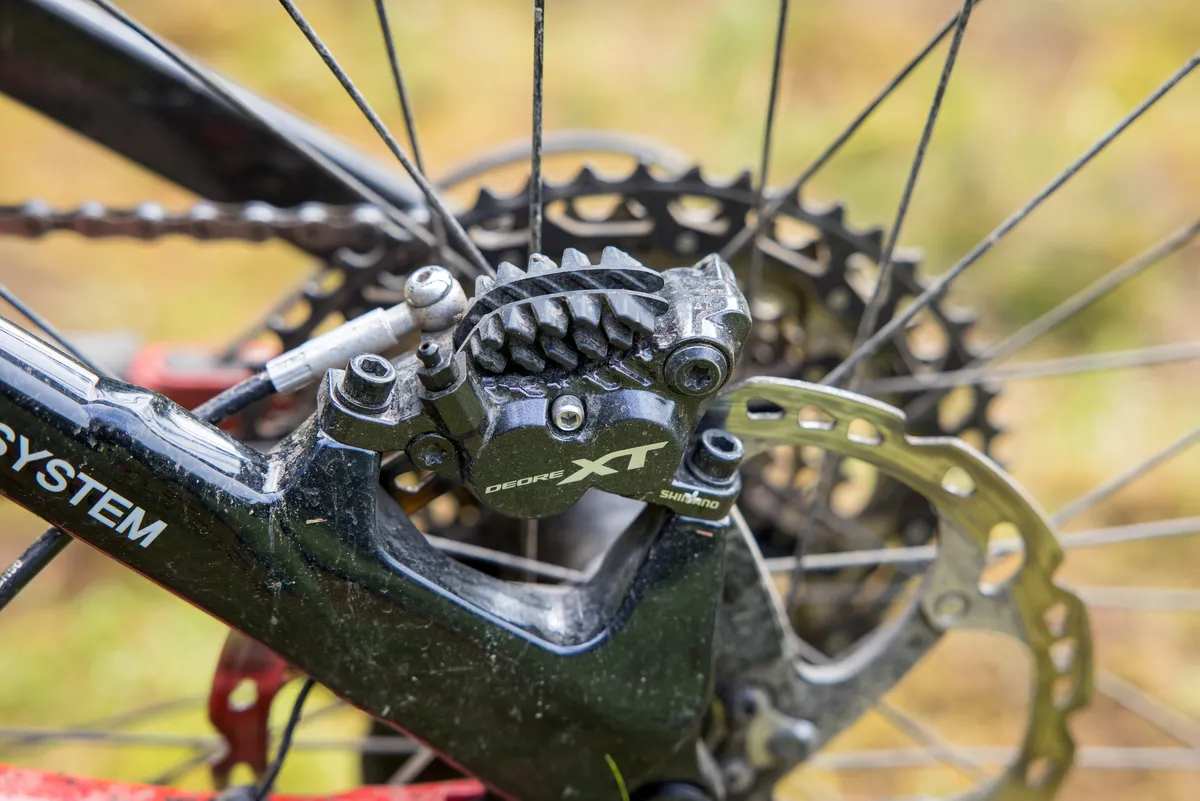
The TK01 R’s Shimano XT M8000-series brakes with four-piston calipers provided incredible amounts of stopping power and had no issues slowing down the Thok’s heft on even the longest, steepest and most brake intensive trails I could ride.
Likewise, the Shimano SLX M7100 / XT M8100 drivetrain mix provided reliable and consistent shifting and the cassette’s 10-51t range gave me plenty of gears for the steepest climbs and fireroad descents.

The Mavic rims shrugged off impacts and torturous terrain well, remaining true and ding-free during the test period.
Despite the dropper post's fairly large stack height, it performed well and its lever was light to operate and ergonomically designed, enabling speedy seat height adjustments.
Tyre woes

However, the EXO+ casing Maxxis tyres proved to be a weak link.
Set up tubeless, it wasn’t long before I punctured the rear tyre – a rock slicing through its carcass.
I also found that unless inflated to 29psi or higher, the rear’s EXO+ carcass squirmed and deformed, burping air when pushed hard through turns. This was frustrating because by increasing pressure that much, I ended up sacrificing a fair amount of grip.
Although the EXO+ casing was much less of a problem on the front of the bike – I didn’t puncture or burp it once when it was inflated to 27psi – the 3C MaxxTerra compound and chunky 2.6in width meant that it lacked bite and chemical traction (how the compound ‘sticks’ to the terrain).
It glided over the trail’s surface rather than clawing onto it. This was most notable on greasier, hardpack trails but was also present on softer ground. This made picking and sticking to lines tricky because the tyres were unable to reduce left and right deflection caused by the terrain.

Although the 3C MaxxTerra compound was less of a problem on the rear tyre, combined with its width it reduced braking traction, once again not providing enough bite as the tyre just skidded over the trail’s surface.
The recurring problem of inappropriate tyre casings on ebikes isn’t exclusive to Thok. I berated Specialized’s latest Turbo Levo for the same reason, but while reducing headline weight figures looks good in brochures, it comes at the price of performance and reliability.
On the Thok, I would personally spec 2.4in or 2.5in wide 3C MaxxGrip Assegais in DoubleDown or DH casings both front and rear and take the weight penalty for the improvement in performance.
Thok TK01 R bottom line

As an overall package, the Thok isn’t bad, especially when you consider the price. Once set up it’s fun to ride on straighter tracks where its chassis is stable and control feels high, with its parts – bar the tyres – all working cohesively together.
If you take the time to learn how it rides to get the most from it, there’s little it can’t handle. However, the way it rides isn’t hugely intuitive – you have to work hard to go quickly and commit more compared to other bikes out there.
It’s great to cruise about on no matter the trail but isn’t as rewarding to ride at its limits. Don’t expect to be able to jump on it and shred the trails instantly, either.
Product
| Brand | thok |
| Price | 6490.00 EUR,5899.95 GBP |
| br_whatWeTested | Thok TK01 R |
| Weight | 23.7300, KILOGRAM (Large) - Size large, without pedals |
Features
| Fork | RockShox ZEB Select |
| br_stem | Thok |
| br_chain | Shimano |
| br_frame | Thok TK01 |
| br_motor | Shimano EP8 |
| Tyres | Maxxis Assegai 3C EXO+ TR 2.6x29in (f), Maxxis Assegai 3C EXO+ TR 2.6x27.5in (r) |
| br_brakes | Shimano XT M8000 |
| br_cranks | FSA |
| br_saddle | Thok Fit |
| br_wheels | Mavic E-XM 430 |
| br_headset | 1.8in |
| br_shifter | Shimano SLX M7100 |
| br_cassette | Shimano SLX M7100 |
| br_seatpost | Thok |
| br_gripsTape | Thok Lock-On |
| br_handlebar | Thok |
| br_rearShock | RockShox Super Deluxe Select+ |
| br_bottomBracket | Shimano EP8 |
| br_availableSizes | Small, medium, large, extra-large |
| br_rearDerailleur | Shimano XT M8100 |
| Features | Thok Control Geometry Plus, Precise Front End, Thok Progressive System, |
